“Make sure you wear your pajamas on Friday for your Shadow a Student Day, because it’s Pajama Day!”
The past few years for my #shadowastudent day I have either shadowed a high school student or an elementary student, so I decided it was time for me to check out what it’s like again to be a middle school student. I met 6th grade student Jake at the arrival of the bus, a quick stop to his locker to drop off our bags and jackets and to gather our materials for classes.
“Can I bring my backpack to class?” I asked.
“No, just a pencil and your iad is needed.”
“Can I bring any snacks?”
“No, but you can have your water bottle if you want.”
And so began my journey as a 6th grader. I followed Jake as he scurried off to meet up with his friends. “Wait for me! Don’t forget your new student!” In my mind, I was thinking…”I hope I don’t lose my pencil. I think I may drop this stuff. Can I survive a morning without my coffee and snack?”
In homeroom, we listened to the music played over the speakers. “Who gets to pick out the music?” I asked. “I don’t know, but I wish I could.” the students replied. Quickly conversations in our group turned to discussions of Fortnite. “How can I play that? Is it a mobile game or Xbox? What’s it all about?” As I learned about Fortnite, we looked on my iPad and phone to see if I could download it. If I was going to learn what it’s like to be a 6th grade boy, I knew Fortnite was key. Without really thinking, I started downloading it on my phone to see what it is, then one student exclaims “She’s downloading Fortnite Mobile right now!” I quickly realize that phones probably aren’t allowed and downloading games in school are doubly not allowed. Oops! Being a student is going to take a lot of getting used to. Thankfully, we were off to our first class of math. “Jake! You need to keep me in line with the rules. I don’t know the school rules and don’t want to be sent to Mr. Marshall’s office today for breaking any rules.”
“Ok, Dr. Cohen. I’ll do my best.”
Math: Choose Your Own Adventure.
 In math class we had a lot of opportunities for choice and movement.
In math class we had a lot of opportunities for choice and movement.
When going over our homework, we were able to choose a partner to check our answers against one another. We could choose to answer the questions on our iPads, in a notebook, or on the worksheet.
After the homework review, we were onto the Choice Board activity. One requirement was that everyone had to do the scavenger hunt. Around the room we had problems posted. With our partner, we would answer the question and then the answer would lead us to the next question in the room. Once we finished the scavenger hunt we were onto the other choice activities, where we had to do at least three in all. We decided to begin with the Ordering Rational Numbers on Number Lines. The three of us worked collaboratively to figure out the order for the mixed fractions. We clearly had mastered the negative vs. positive numbers, but when multiple fractions were in the mix, it started to get tricky, but still doable. I was impressed how Jake knew many of the fractions in his head and convert them to decimals and I may have taken my phone out to use the calculator on some to make sure I was putting them in the right order. Use the tools you have, right? I asked Jake the question I always ask, “When do you think we will ever have to use this skill in life of putting mixed rational numbers on a number line?” We couldn’t come up with an answer right then, which is a shame, because we were really good at it! Just as we finished all 8 of them, we were off to our next class, which was our special…French!
French: Bon Jour, Madame!
In French class, we began by sitting in whatever seats we wanted to sit in. According to one of my new 6th grade friends, it is important to get there early so you can grab the coveted seats in the back against the wall. Because we arrived early we had some time to chat. Quickly conversation turned to….
- “Do you think that Fortnite will be the most popular game 20 years from now?”
- “Definitely not, I can’t even imagine what types of games there will be in 20 years.”
- “Who are you? Are you the new student? Why are you shadowing Jake? Is he in trouble or something?”
- “Hey, I think this year is my last year in baseball. I’m going to focus on just basketball in the future.”
- “Do you know if people who pledge allegiance to their own flags in other countries put their right hand over their heart like we do?
Our teacher started class and called us by our French names and asked us to introduce ourselves using our French assigned names and greeting our teacher in French. Then we were off to our daily Quizlet Live activity where we are assigned to groups by the app and we work together to identify the proper French phrases to match with the English greetings. I apologized to each of the groups that I only knew a couple of French phrases so they will have to help me out. After three rounds, where I completely failed my teammates, (except for the phrases of Bon Jour and Merci), we went back to our coveted seats.
The final part of the class, we were supposed to find a partner who we can practice a dialogue of greetings where we say hello, ask their name, tell their name, say nice to meet you and practice without looking at our notes. Somehow, our partner activity turned into a group of 4 boys and me where some of us practiced the greetings (at least when the teacher was around). At the end of class, she asked for volunteers and our many friends were ready to move around and jumped up for numerous practice sessions in front of the class (in their animal pajama costumes of course!)
As I watch these presentations towards the end of the class, I start to realize how hungry I was. All I can think about was lunch, which I learned was still an hour away. I started thinking of how I wish I had my bag, (which had my snacks in it,) and also started contemplating how I might sneak out to grab a snack before a faint from low blood sugar….but no time for that as we were off to Science!
Earth Science: Picture this!
Once we were in science class, we were quickly put into two large groups and given the instructions that we will be playing a modified form of Pictionary to review our understandings of various types of volcanoes. We were instructed to pick four people who will be the ones who draw and I have to admit, at first it was a bit of mayhem as each group of students had to decide on the 4 as almost all wanted to participate. Then, quickly they started to put some strategies in place, which was really interesting to observe. I saw a few leaders jump up and try to take charge of the group, then I heard one of the boys say “we need to make it even, 2 girls/2 boys,” then someone declared “let’s do it by birthdays, that’s fair!” and finally a battle came down to two who did rock/paper/scissors for the final choice. It was impressive to see the students come to a resolution through various methods of decision-making.
What did I learn about volcanoes? I learned about magma chambers, side vents, the pipe, and crater as part of the anatomy of a volcano.
Also, fun fact: Did you know that Pahoehoe eruptions can have two kind of lava: Pahoehoe rock forms from hot, fast, thin and runny lava. When it cools it becomes smooth rock that looks like rope-like coils. Aa rock forms from thicker, cooler, slower-moving lava. When it cools it becomes rock with a rough, jagged surface.
Lunch Time
I have to admit, I was kind of excited for lunch time after learning about volcanoes, and I was about 90 min past my typical mid-morning snack. While in line, I asked the girls behind me what they recommend and what the big-seller was and they said definitely the chicken nuggets. Then when I was paying, there was a wide array of unhealthy snacks (my favorite) and I asked what the most popular one sold was and was informed that it was rice krispies treat so I went for that. I saw the students crowded around the condiment table and observed that it is normal to put as much ketchup as you possibly can into the unused portion of my tray. I also observed that we eat everything on our plate, except for the vegetable. Surprisingly, despite taking photos and talking to my new friends at the table, we did have plenty of time to eat our lunch. We had to clean up our table before we were dismissed to recess, which was about 5 minutes outside in the parking lot in the cold, without a jacket (because apparently 6th grade boys don’t wear jackets out to recess).


ELA: Visible Thinking

After lunch, we headed back into our ELA class where we were partnered up for some partner discussions (3 rounds) on the NEWSELA articles the students had read in a previous class. We discussed some big questions from our articles:
1. What surprised me? How did the author do this?
2. What did the author think I already knew? How did this impact my understanding?
3. What challenged, changed, or confirmed what I knew? How did the author accomplish the purpose?

In this process I learned about how an olympic snowboarder lost his jacket in the morning of a competition; how math can help with March Madness brackets; how marine animals, turtles, and whales have the same moves, and how California is aiming to protect it’s animals through legislation. What was very apparent through this activity was that the students loved being able to read and learn about content that interested them through the NEWSELA article access. The boy who chose the snowboarder article is an avid snowboarder himself and does competitions throughout the weekend. The boy who chose to learn about math in March Madness is really interested in basketball and was surprised to learn how much math can be incorporated into the process. Another observation was how well the students carried on discussions about the articles to share their learning with one another. They asked great questions and were extremely respectful of one another, even when matched with different students who weren’t their close friends.
Social Studies: Time to Present
In our last class of the day, it was time to present about Ancient Egypt. Each student had come in prepared with a topic about Ancient Egypt. All of the audience participants were provided a presentation rubric, as well as an audience participation sheet to take notes on. I learned about Egyptian Fashion, the structure and function of pyramids and then Egyptian cuisine. After each of the presentations, the audience members provided three pieces of positive feedback and with the cuisine presentation we even got to try some snacks!
This slideshow requires JavaScript.
Wellness Week: High Altitude
The end of the day we were dismissed to an all-school assembly in recognition of Wellness Week. We were dismissed by grade levels, which put the 6th grade in the front row on the floor in the gym, where we had a great view of the amazing jump rope team representatives from MURSD High Altitude. They got the crowd clapping and cheering and we all were amazed by their skills. It certainly was an amazing end to the day and the week.
What were my big take-aways?
- The day of a 6th grader is busy, yet not hectic. We had enough time for transitions, lunch, and enough mixture of being “on” with having time to talk to our friends.
- All of the teachers put in a lot of time to craft engaging activities that get us either moving or interacting with our peers
- My favorite time was when students had the opportunity to talk about their interests, either in ELA with their choice articles or in conversations with their peers about their passions.
- Our students are extremely respectful of diverse opinions and students with different learning styles. I saw elements of inclusion and respect in all classes.
- Finally, it is really fun to be a 6th grader.













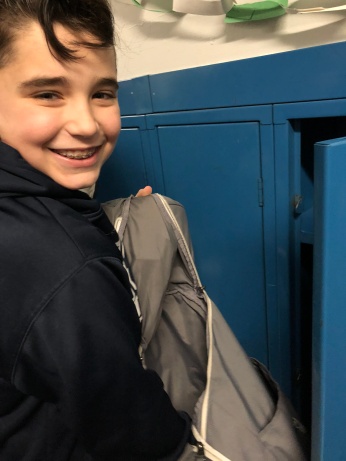
 In math class we had a lot of opportunities for choice and movement.
In math class we had a lot of opportunities for choice and movement.



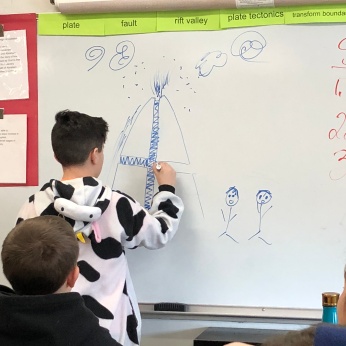












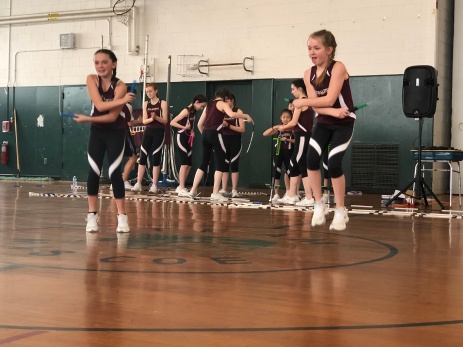




 Connor (12):
Connor (12):  Liam (9):
Liam (9): 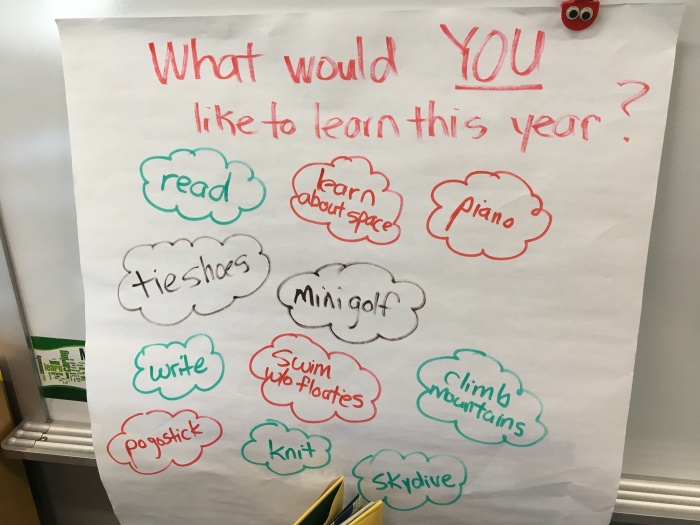







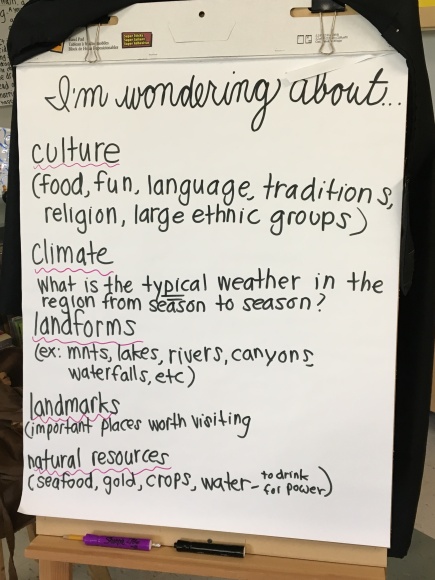
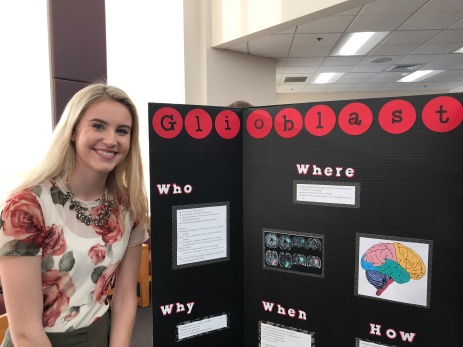




 It was a Saturday, this summer, and I just came into the house and saw my son Connor (11) sitting at the kitchen table with a laptop, a notebook, pencil, and a bird’s nest in the middle of the table. He was leaning into the computer, his hand furiously writing notes in his notebook, that he didn’t even notice me enter. I walked over to him and did what any mother would do, I asked him with a flare of incredulousness and loud emphasis, “Connor, what are you doing? Why is there a bird’s nest in the middle of my kitchen table?”
It was a Saturday, this summer, and I just came into the house and saw my son Connor (11) sitting at the kitchen table with a laptop, a notebook, pencil, and a bird’s nest in the middle of the table. He was leaning into the computer, his hand furiously writing notes in his notebook, that he didn’t even notice me enter. I walked over to him and did what any mother would do, I asked him with a flare of incredulousness and loud emphasis, “Connor, what are you doing? Why is there a bird’s nest in the middle of my kitchen table?” Connor, how was school today? What did you learn?” Connor’s response, “Oh, it was good.” I was thrilled with a strong “good” response and inquired further with a little excitement, “Good, that’s great! What was so good about it? What did you learn? Something new? Did you do anything fun?” Connor, gave me a funny look, a roll of the eyes, and said with a tone that only a 6th-grader could master, “It was FINE, Mom. You know, it is just school. It is always the same.”
Connor, how was school today? What did you learn?” Connor’s response, “Oh, it was good.” I was thrilled with a strong “good” response and inquired further with a little excitement, “Good, that’s great! What was so good about it? What did you learn? Something new? Did you do anything fun?” Connor, gave me a funny look, a roll of the eyes, and said with a tone that only a 6th-grader could master, “It was FINE, Mom. You know, it is just school. It is always the same.”


 as a whole.
as a whole.


 As educators, when asked if we should increase “student voice” in the classroom or schools, our quick response is often “Yes, of course!” However, in reality, are we really, truly engaging our students in leading our schools, having a say in our curriculum, contributing to our decision-making? I know we do try. For example, we have student councils, we ask for student input in surveys, we give choice to students in projects, we ask them to self-reflect and students participate on some committees. We ask for their feedback, we listen, right? However, student voice needs to go beyond just listening.
As educators, when asked if we should increase “student voice” in the classroom or schools, our quick response is often “Yes, of course!” However, in reality, are we really, truly engaging our students in leading our schools, having a say in our curriculum, contributing to our decision-making? I know we do try. For example, we have student councils, we ask for student input in surveys, we give choice to students in projects, we ask them to self-reflect and students participate on some committees. We ask for their feedback, we listen, right? However, student voice needs to go beyond just listening. where they were asked a series of questions about the school such as:
where they were asked a series of questions about the school such as: Yesterday, I was lucky to participate in a 3rd grade tea that was being held for seniors in the community. Sitting in the middle of a table of about 11, third graders, it was an opportunity for me to ask them about their school experience. Coming off of the high school discussion recently, I figured I’d stick to some of the same questions. I asked them: 1. “What do you like most about coming to school?” 2. “If you could change one thing about school, what would it be?” 3. “What is your favorite subject?” The students eagerly shared their love for math (that was the #1 choice around the table) and we had a few who liked reading. Some wished they had more time for recess, and thought the end of the day would be the best time to do that before leaving for the day. They said they wished they had more opportunities to learn science, and they shared their favorite books of choice. They liked their music class and were looking forward to learning to play musical instruments in the future. They wanted less homework, but admitted they didn’t have too much each night and Lexia was a big hit because they found it to be a fun way to learn. WOW! That’s A LOT of feedback.
Yesterday, I was lucky to participate in a 3rd grade tea that was being held for seniors in the community. Sitting in the middle of a table of about 11, third graders, it was an opportunity for me to ask them about their school experience. Coming off of the high school discussion recently, I figured I’d stick to some of the same questions. I asked them: 1. “What do you like most about coming to school?” 2. “If you could change one thing about school, what would it be?” 3. “What is your favorite subject?” The students eagerly shared their love for math (that was the #1 choice around the table) and we had a few who liked reading. Some wished they had more time for recess, and thought the end of the day would be the best time to do that before leaving for the day. They said they wished they had more opportunities to learn science, and they shared their favorite books of choice. They liked their music class and were looking forward to learning to play musical instruments in the future. They wanted less homework, but admitted they didn’t have too much each night and Lexia was a big hit because they found it to be a fun way to learn. WOW! That’s A LOT of feedback.
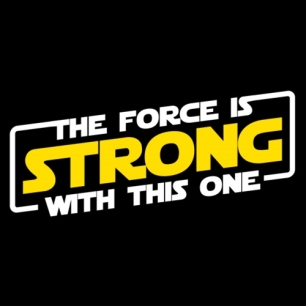
 During the Help Desk in the morning, we had an opportunity to talk about what she liked best about school, what her favorite classes were, and what her goals were in the future. In P.E. class, we laughed as I tried to show my ‘mad’ skills in badminton during a tournament. At break, we hung out with all of the other juniors in the media center and I was schooled in professional wrestling and the students’ interest in watching that.
During the Help Desk in the morning, we had an opportunity to talk about what she liked best about school, what her favorite classes were, and what her goals were in the future. In P.E. class, we laughed as I tried to show my ‘mad’ skills in badminton during a tournament. At break, we hung out with all of the other juniors in the media center and I was schooled in professional wrestling and the students’ interest in watching that.
 As someone who has attended many School Board meetings over the last decade, this was probably one of the most educationally focused and friendly one I’ve ever witnessed!
As someone who has attended many School Board meetings over the last decade, this was probably one of the most educationally focused and friendly one I’ve ever witnessed! 


 n…..I went to the Memorial Elementary School Veteran’s Day concert on Thursday, November 10th. The most adorable children, ages 3-10, decked out in red, white, and blue, sang their hearts out to recognize our local servicemen and women. That moment centered me. It drowned out the noise and negativity of social media discourse and gave me hope for a bright future.
n…..I went to the Memorial Elementary School Veteran’s Day concert on Thursday, November 10th. The most adorable children, ages 3-10, decked out in red, white, and blue, sang their hearts out to recognize our local servicemen and women. That moment centered me. It drowned out the noise and negativity of social media discourse and gave me hope for a bright future.